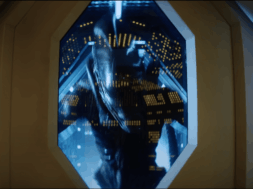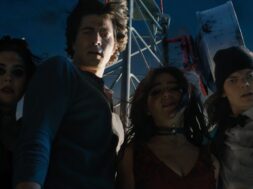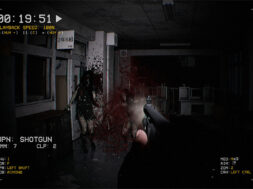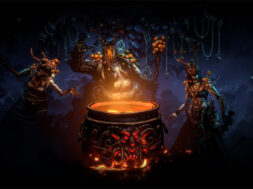Can Fish Really Scream?! Johannes Roberts Addresses the Inaccuracies of ’47 Meters Down: Uncaged’
The smash hit 47 Meters Down and its new sequel, 47 Meters Down: Uncaged, are productions unlike almost any others. The majority of the action takes place underwater, with the lead actors in scuba suits, as they are trapped in a cage or, in the sequel, a submerged underwater city.
It’s a novel setting and set-up for a motion picture, but the practicalities of shooting underwater, in a dark environment, where sound design is unlike anywhere in the open air and where the characters wouldn’t normally be able to talk to each other makes telling either of the 47 Meters Down stories incredibly complicated.
And – as Bloody-Disgusting learned in a new interview with Johannes Roberts, who directed both films – it forced the filmmakers to get inventive, stretch the truth a bit, and be more impressionistic in their storytelling.
“For me what works about both movies is that they’re actually,” Johannes Roberts said, “as preposterous as they are, you know, they’re movies.”
“There was a wonderful three-page thesis someone wrote on the first movie about the inaccuracies of the diving stuff. And yeah, sure!” Roberts laughed. “But you know, if you went down 47 meters in a cage to the bottom of the ocean, with a tank, and you were an inexperienced diver, you would probably last about three minutes before you died or ran out of air.”

“So yeah, sure, it is ridiculous. And full-face masks are not a thing your really dive with in reality and you know, there’s all these kind of things. But it is a movie, you know?” Roberts added.
But although full face masks aren’t conventional scuba gear, there was one piece of Hollywood fakery that Roberts eschewed while making the 47 Meters Down films.
“Most of these movies people would just illuminate the masks,” Roberts explained. “It was really fucking hard to light that movie. But it just felt too sci-fi, because it’s such a sci-fi thing to do. You wouldn’t normally have lights in a mask because you can’t actually see out of a mask if you have that.”
“So we really tried to keep it, in its own way, grounded, even though the movie goes off in its own direction. So we had to create different ways to light the movie throughout, to tell the story with light throughout the hour-and-a-half. I think we’d be with alarms and flares and flashlights and working lights and then open-air caves, and stuff like that. It was a very tricky thing to do, to create this kind of journey of light, because really that’s your biggest way you can tell a story in a movie like this,” Roberts explained.

But lighting isn’t the only problem when you’re shooting underwater in caves. There’s also the tricky problem of sound design.
“Yeah, that was a crazy job. But I have such a good team. They did the first movie. I mean the sound design on this movie is so complex. It’s unbelievable even for me. You know, I see what these guys are doing, it’s incredible. And then you sort of complement that, the incredible work they do, with Tomandandy’s score, really going for it with the score, and then obviously I’m really into source music and telling stories with great source tracks,” Roberts added.
“So we had fun on that as well, picking out these songs like “We’ve Only Just Begun” and then using the whole underwater, echoing, cavernous sound to really play with that, you know? It was a fun one, the sound on this,” he said.
But sometimes, the need to tell the story through sound can be slightly more important than accuracy. [SPOILER ALERT]

Case in point: the scene where a tetra fish shrieks at our heroes, underwater, causing them to recoil and cause a cave-in. Do fish actually DO that…?
“The tetra,” Johannes Roberts laughed. “You know, I have no idea. We tried several things with it and it was in the very early stages, they put on a shrieking sound. And it was it just like, you know what? It fucking needs to do that for the moment. I wouldn’t want to necessarily swear to it, that that’s a very accurate thing that fish do.”
Indeed, it was arguably a storytelling necessity, because the audience needs to sympathize with how scary the moment is for the protagonists, since their extreme reaction creates a domino effect that pushes the story forward.
“We tried various ways of doing [it]. You know, tried the moving, tried different sound design. And you know, it wasn’t written to have any sound on it. But it just didn’t feel impactful enough,” Roberts explained. “You needed the audience to really sort of jump at that moment, so yes, yes. I could have done it musically but…”

But… being realistic and feeling realistic aren’t always the same thing.
“I think to me where I connect with the movie is, actually, they are grounded in [something],” Roberts said. “I am a diver myself. I love diving. I love sharks. And there is actually an element where it comes from, the stuff you’re doing. Laying a guideline, all this kind of stuff, what caves look like down underwater. I’ve done all that. I’ve been there. The sediment in the water, and elements like that. Going through thin cracks and stuff.”
“I’ve sort of been there, that stuff does have an element of realism in it,” the director concluded.
You can see for yourself how accurate 47 Meters Down: Uncaged really is. It’s in theaters now!









